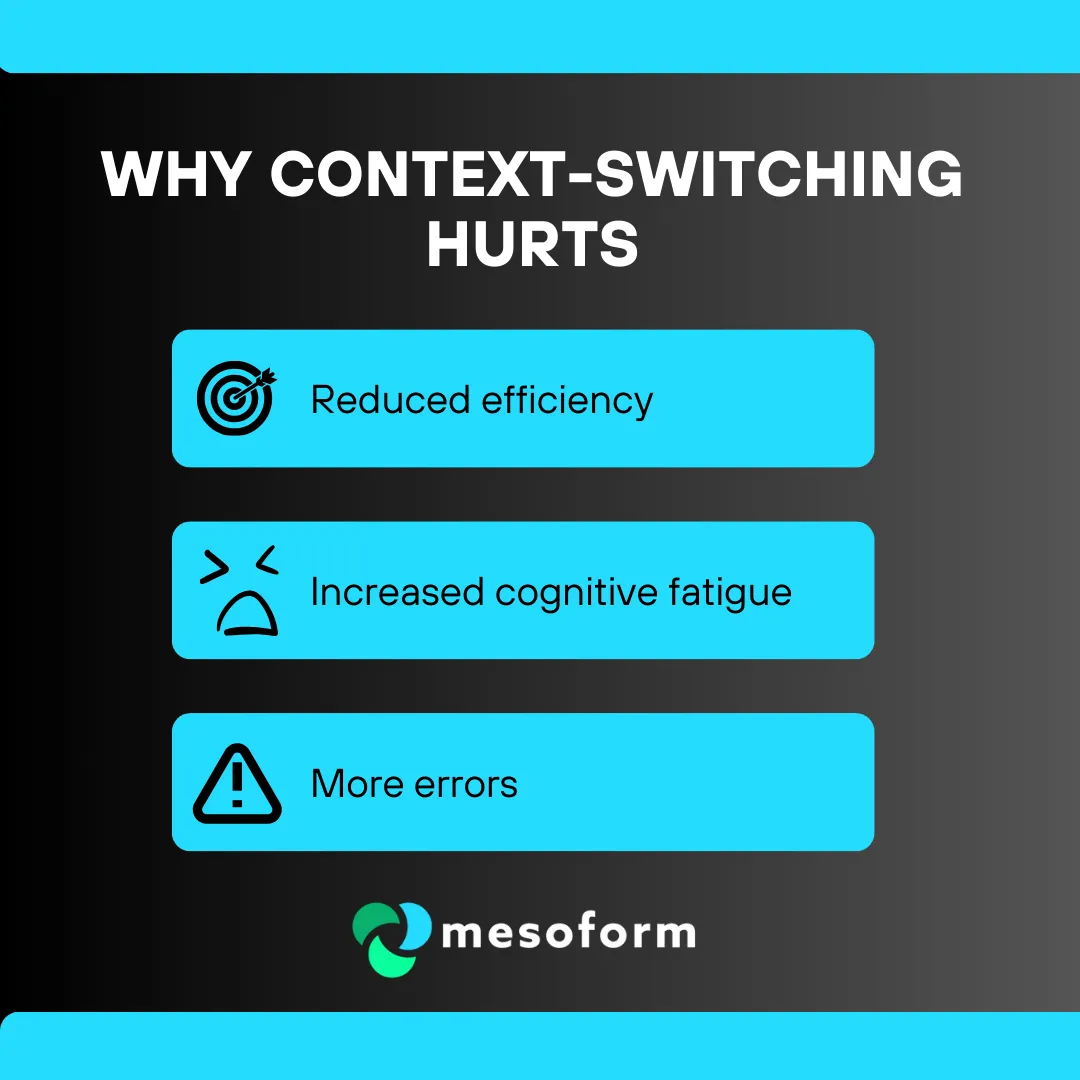Blog
Case studies, strategies, and ideas shaping modern technology.
The Hidden Costs of Context-Switching: Why Developers Need Focus to Thrive

Cutting corners by making developers handle non-specialist tasks might seem like a money-saver, but it often backfires. Every distraction, whether unnecessary meetings or out-of-scope work, slows progress. Context-switching is an invisible drain on productivity, and if ignored, it can derail entire projects.
The fix? Platform engineering and internal developer platforms (IDPs). By centralising and automating development workflows, IDPs remove distractions, keep developers focused on their core work, and ultimately save time and money.
This blog unpacks why context-switching is so damaging, its impact on performance, and how an IDP can be the key to eliminating it. If you want a more productive development team and real cost savings, read on…
The True Cost of Context-Switching
The Silent Productivity Killer
What disrupts developers the most? It’s not just lengthy meetings or excessive emails—it’s context-switching. Research indicates that even a brief interruption can take up to 23 minutes to fully recover from. This isn’t just about lost minutes—it’s about lost mental momentum, increased cognitive load, and diminished code quality.
Why Context-Switching Hurts
Unlike computers that can instantly pause and resume processes, the human brain requires time to recalibrate. When developers are constantly switching between coding, debugging, emails, and meetings, they must mentally reload their progress each time. This results in:
- Reduced efficiency: More time spent ramping up means less time coding.
- Increased cognitive fatigue: Constant task-switching drains mental energy, leading to burnout.
- More errors: Frequent interruptions lead to oversight and increased bug rates.

How an Internal Developer Platform Eliminates Context-Switching
Platform engineering provides a structured, self-service environment that allows developers to focus on writing code rather than dealing with infrastructure, configuration, or other operational overhead. An internal developer platform (IDP) eliminates common distractions by:
- Automating repetitive tasks: CI/CD pipelines, environment provisioning, and dependency management become seamless.
- Providing self-service tools: Developers can deploy services, spin up environments, and debug issues without waiting for DevOps or IT.
- Standardising workflows: With a unified platform, developers spend less time figuring out tooling inconsistencies and more time coding.
- Reducing unnecessary meetings and approvals: Automating governance and compliance means fewer manual checks.
By implementing an IDP, organisations ensure that engineers remain in flow state, working on high-impact tasks instead of dealing with friction points.
Flow State and Developer Productivity
What is Flow State?
Flow is a state where work feels seamless and deeply engaging. Mihaly Csikszentmihalyi, who coined the term, found that achieving flow takes approximately 15 minutes of uninterrupted focus. However, even a minor disruption—such as a Slack ping or email notification—can break flow instantly.
How an IDP Supports Developer Flow
To support developers in reaching and maintaining flow, organisations should:
- Automate infrastructure management: Remove the need for developers to configure and troubleshoot environments manually.
- Enable instant feedback loops: CI/CD pipelines and real-time observability tools keep developers in control without unnecessary meetings.
- Create self-service deployment environments: Reduce dependencies on operations teams, allowing developers to ship faster.
- Ensure minimal disruptions with clear workflows: IDPs enforce best practices that reduce back-and-forth communication and manual processes.
Teams that prioritise flow with an IDP see tangible improvements in project completion rates, code quality, and overall job satisfaction.
Strategies to Reduce Context-Switching
For Developers:
- Use an IDP for self-service deployments: Eliminate the need to wait for DevOps to provision resources.
- Automate local development environments: Ensure every engineer has a consistent setup with infrastructure-as-code tools.
- Integrate issue tracking and observability tools: Keep troubleshooting contained within the development workflow.
- Minimise external distractions: Use Do Not Disturb modes and structured asynchronous updates.
For Teams:
- Centralise documentation and processes within the IDP: Reduce time wasted searching for information.
- Implement CI/CD automation: Remove the need for manual intervention in the release process.
- Standardise development environments: Prevent context-switching caused by inconsistencies across teams.
- Enforce role-based access and permissions: Ensure developers have the right access without unnecessary approvals.

Measuring the Impact of Reduced Interruptions
To track success, monitor key metrics such as:
- Frequency of unplanned interruptions: How often are developers pulled into non-essential tasks?
- Duration of uninterrupted coding sessions: Are developers getting sufficient deep-work time?
- Code quality and bug reports: Is the reduction in distractions improving code output?
- Team satisfaction scores: Are developers feeling more engaged and less frustrated?
- Sprint velocity improvements: Is the team delivering features faster with fewer delays?
Conclusion
Interruptions don’t just waste time—they degrade work quality, slow down projects, and increase frustration across teams. By prioritising platform engineering and internal developer platforms, companies can dramatically improve productivity, code quality, and overall efficiency.
The first step? Implement an IDP—automate workflows, remove unnecessary dependencies, and free developers to focus on what they do best. The results will speak for themselves, and your developers (and your bottom line) will thank you.
Ready to take your development team’s productivity to the next level? Start implementing an internal developer platform today. If you’re looking for expert guidance on platform engineering and workflow optimisation, get in touch with us!
Want to explore more insights on DevOps and platform engineering?
Check more of our blogs:
- Demystifying Platform Engineering: Connecting the Dots Between DevOps and Site Reliability Engineering (SRE)
- Demystifying SRE (Site Reliability Engineering)
- Demystifying DevOps: Transforming Software Delivery and Collaboration
- Shifting Left Vs Shifting Down
- https://www.mesoform.com/resources/blog/case-studies/internal-notifications-for-cloud-monitoring
If you would like to discuss any of these topics in more detail, please feel free to get in touch

